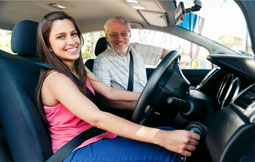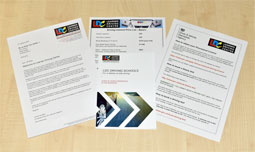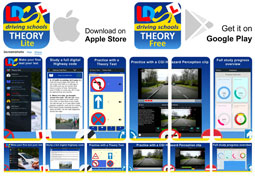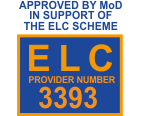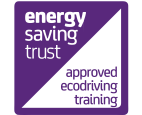Driving lesson 4. Co-ordination
Introduction
Now we have covered the basic skills of moving off on the level, changing gear and steering, you can use them to help with slightly more complex manoeuvres.
Key learning notes
 Moving off uphill
Moving off uphill
To move off uphill use more gas to give you enough power to move away slowly and smoothly. When it is safe to move away release the handbrake gently. If the car begins to roll back, just bring the clutch up a little more.
 Moving off downhill
Moving off downhill
No gas! Let gravity do the work for you. Control the speed with the foot brake bringing the clutch up gently as soon as possible. The steeper the gradient the higher the gear you should start in.
Moving off at an angle
You may need a signal, even if you think there is no one to benefit. When moving off at an angle it is harder to see and be seen. Check your blind spot at least twice. As you are moving off slowly, other vehicles may approach. Use clutch control to keep your speed down until you have straightened your wheels.

Mirror use
When using the mirrors make sure you do not take your eyes off the road ahead for too long. Use quick glances and minimal head movement. Register what you see, and ask yourself these questions:
- Are there any vehicles behind or to the side?
- How fast are they travelling?
- How close are they?
- Are they signalling?
Once you have collected this information consider whether they will affect you and whether you need to take any action. As a minimum you need to know this before you signal, change direction, or change speed. If you are stationary you also need to know this before you open the car doors.
The following diagrams illustrate why you need to use your mirrors frequently.
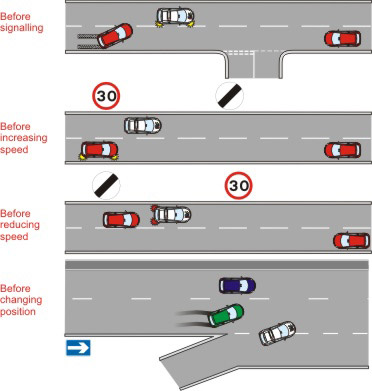
Check your mirrors before signalling to see what traffic behind is doing and what their intentions are.
Check your mirrors before changing speed.
Check mirrors before changing direction.
Signal use
Signals should only be used to help warn other road users of your intended actions or your presence. If other road users will not benefit from a signal then a signal may not be necessary.

See the Highway Code for the precise meaning of all these signals. Timing your signal is important. Too early and it may be misleading, too late and other road users may not see or hear it, or have time to react to it.
Arm signals can be used to reinforce the signals on the car.

Horn
The horn should be used to warn other road users of your presence. Use this signal when approaching a narrow hump backed bridge or when negotiating a narrow bend.
Passing stationary vehicles
When driving you will encounter vehicles parked at the side of the road. The general rule is that the driver with the obstruction on their side of the road should give way to oncoming traffic.
 When approaching a stationary vehicle use the MSM routine. Check your interior and right door mirror to see if it is safe to give a signal and if so determine whether it would benefit anyone. Move out to just left of the centre of the road to gain a better view of any oncoming traffic. If you cannot overtake the stationary vehicle without affecting any oncoming traffic, slow down and be prepared to stop two car lengths behind the parked vehicle, this is called the 'hold back position'.
When approaching a stationary vehicle use the MSM routine. Check your interior and right door mirror to see if it is safe to give a signal and if so determine whether it would benefit anyone. Move out to just left of the centre of the road to gain a better view of any oncoming traffic. If you cannot overtake the stationary vehicle without affecting any oncoming traffic, slow down and be prepared to stop two car lengths behind the parked vehicle, this is called the 'hold back position'.
Maintain adequate clearance as you pass the stationary vehicle, about a metre if possible.

On busy housing estates you can sometimes be confronted with the problem of meeting traffic head-on where it is difficult to determine who has priority. Anticipation and common courtesy play an important role when dealing with this situation.

Try to ensure that you are seen and if possible gain eye contact with the driver of the approaching vehicle. Assess the speed and distance of the approaching vehicle. If you are confident that you will reach the gap before the oncoming vehicle it is likely that the other driver will give you priority but do not assume it. The narrower the gap and the more pedestrians about, the slower your speed should be.
Passing places
On single track roads you will often find passing places to allow oncoming vehicles to pass. If the passing place is on your left hand side then you should wait in the passing place. If it is on your right hand side you wait opposite the passing place in such a position that the oncoming vehicle can move into the passing place area.
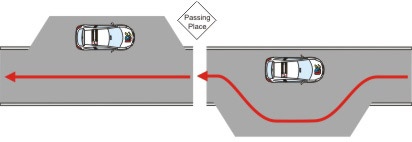
Traffic calming measures
In housing estates it is becoming more common to find various types of traffic calming measures. The most common is a speed hump, which can be either a small hump or a large plateau that stretches across the full width of the road. The speed limit in such an area can be 20mph or less, so look out for the signs.
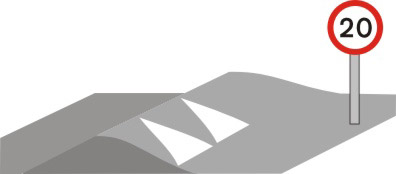
You may also find other types of traffic calming measures such as extended causeways, treat these the same as you would a parked car.

Mini roundabouts can also be used as a traffic calming measure. If these are common in the area you are driving you need to look at the basic rules for dealing with them in driving lesson 9.
Highway Code study
Rules: 110 - 112, 152 - 156, 161 - 163, 212, 213.

